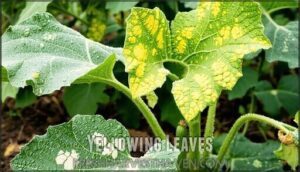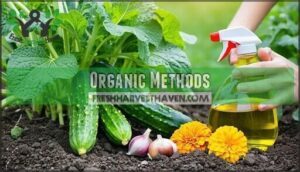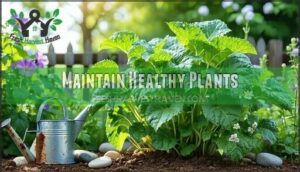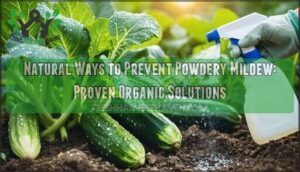This site is supported by our readers. We may earn a commission, at no cost to you, if you purchase through links.
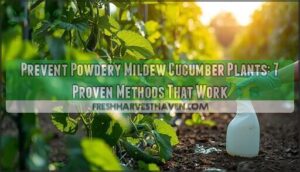
Space plants properly for airflow, water at soil level rather than leaves, and maintain consistent moisture without overwatering.
Remove any infected plant material immediately, and consider applying preventive milk sprays or baking soda solutions weekly during humid conditions.
The key is creating an environment where spores can’t establish themselves in the first place, using these seven battle-tested methods that work together like a defensive shield, but timing and technique make all the difference.
Table Of Contents
- Key Takeaways
- Prevent Powdery Mildew
- Recognize Mildew Symptoms
- Control Mildew Spread
- Treat Mildew Infections
- Maintain Healthy Plants
- Frequently Asked Questions (FAQs)
- Is vinegar or baking soda better for powdery mildew?
- What is the best spray for powdery mildew on cucumbers?
- What is the best way to prevent powdery mildew?
- What is the best preventive spray for powdery mildew?
- How do you stop powdery mildew on cucumber plants?
- How do you control mildew on cucumbers?
- Can powdery mildew spread to nearby plants?
- What are long-term effects on soil health?
- Are there natural predators against powdery mildew spores?
- Does crop rotation help prevent powdery mildew?
- Conclusion
Key Takeaways
- Choose disease-resistant cucumber varieties like ‘Marketmore 76’ or ‘Diva’ to reduce mildew infections by 60-90% compared to susceptible types.
- Space your plants 18-24 inches apart and provide 8+ hours of direct sunlight daily to create proper airflow and prevent the humid conditions mildew needs to thrive.
- Water at soil level using drip irrigation or soaker hoses instead of overhead watering to keep leaves dry and prevent spore germination.
- Apply weekly preventive treatments like baking soda spray (1 tablespoon per gallon of water) during humid conditions and remove infected plant material immediately to stop spread.
Prevent Powdery Mildew
Prevention starts with selecting disease-resistant cucumber varieties that can reduce powdery mildew severity by 60-80% compared to susceptible types.
Smart gardeners cut mildew risk by 60-80% with one simple choice: disease-resistant cucumber varieties.
You’ll also need to create ideal growing conditions with full sun exposure, proper spacing for air circulation, and consistent soil-level watering to keep leaves dry, which helps in prevention.
Choose Resistant Varieties
Why settle for vulnerable cucumber varieties when resistant cultivars offer superior disease tolerance? Plant breeding has produced mildew resistant cucumbers like ‘Marketmore 76’, ‘Diva’, and ‘Ashley’ that reduce infection rates by up to 90%. Smart variety selection protects your harvest.
Choose resistant cultivar selection with these priorities:
- Seed choices from reputable suppliers with PMR ratings
- Disease-resistant varieties suited to your growing zone
- Mildew-resistant variety selection balancing resistance with fruit quality
Create Healthy Environment
Creating the right environment is your strongest defense against powdery mildew on cucumber plants. Soil Quality forms the foundation—guarantee well-draining soil that doesn’t retain excess moisture. Plant Spacing of 18-24 inches between plants promotes Air Circulation, preventing the stagnant conditions fungi love.
Good air circulation isn’t just helpful—it’s your cucumber plants’ lifeline against powdery mildew’s suffocating grip.
Position your cucumbers where they’ll receive at least 8 hours of Sun Exposure daily, as morning sunlight helps dry leaves quickly. Water Management** requires precision—water at soil level using drip irrigation or soaker hoses to keep foliage dry.
Humidity Control improves when you avoid overhead watering and guarantee proper drainage. These conditions are crucial for preventing the spread of powdery mildew.
| Environmental Factor | Optimal Condition |
|---|---|
| Air Circulation | 18-24 inch plant spacing |
| Watering Techniques | Soil-level irrigation only |
| Sunlight Exposure | 8+ hours direct sunlight |
These watering techniques combined with strategic positioning create an environment where powdery mildew simply can’t establish itself effectively.
Implement Cultural Practices
Proper cultural practices create the foundation for mildew-free cucumber gardens. Start with soil preparation by rotating crops annually to break disease cycles.
Focus on plant spacing that allows adequate air circulation between vines. Use vertical training systems like trellises to improve airflow and light penetration. Apply mulching benefits around plants to stabilize soil moisture while preventing spore splash.
Additionally, understanding powdery mildew symptoms is essential for early detection and effective prevention.
- Cucumber vines climbing wooden trellises with morning sunlight filtering through leaves
- Garden rows with perfectly spaced plants allowing gentle breezes to flow freely
- Rich, dark mulch creating a protective barrier around healthy green stems
- Clean pruning shears removing lower leaves to open up dense plant canopies
Recognize Mildew Symptoms
You’ll know powdery mildew is attacking your cucumber plants when you spot pale yellow spots on leaves that quickly develop into white, dusty patches.
Early detection is essential because once you can see the telltale powdery coating, the fungus has already established itself and can spread rapidly to other parts of the plant.
Identify Early Signs
Catching powdery mildew early saves your cucumber plants from serious damage. Watch for pale yellow leaf spots on older leaves – these visual cues signal fungal spores have landed.
Early detection means spotting subtle changes before obvious white powdery coating appears. Leaf symptoms start as faint discoloration, then progress to powdery patches.
Check lower leaves first since they’re most vulnerable. Mildew warning signs include twisted leaf edges and stunted growth patterns.
Understanding powdery mildew causes is essential for effective prevention and treatment.
White Powdery Coating
Recognition becomes vital when a white powdery coating appears on your cucumber leaves—this telltale fungal growth signals active cucumber powdery mildew.
You’ll notice this distinctive white powdery coating resembles flour dusted across leaf surfaces, starting small before expanding rapidly through spore spread.
The coating typically emerges during periods of poor humidity control, creating perfect conditions for mildew development.
This leaf damage initially appears as small circular patches that merge into larger affected areas.
Prompt coating removal through gentle washing can help slow progression, but addressing underlying mildew prevention strategies remains essential for effective mildew control and protecting your cucumber harvest.
Yellowing Leaves
Yellow spots along leaf veins signal powdery mildew advancing beyond surface coating.
Leaf damage intensifies as fungal infection blocks photosynthesis issues, creating nutrient deficit symptoms.
Environmental stress accelerates yellowing leaves progression.
Mildew on cucumber leaves spreads systematically through vascular tissue.
Early powdery mildew treatment prevents cucumber leaf problems from destroying plant health.
Cucumber disease prevention stops this destructive cycle.
Control Mildew Spread
Once powdery mildew appears on your cucumber plants, you’ll need to act fast to prevent it from spreading to healthy foliage.
The key is combining immediate removal of infected plant parts with targeted treatments that stop spores from establishing new infections, which is crucial for preventing the spread.
Organic Methods
Once you spot those telltale white patches, you’ll want natural solutions that won’t harm your harvest.
Organic mildew control offers effective powdery mildew treatment without harsh chemicals.
- Neem oil spray: Apply weekly to disrupt spore germination and suffocate existing fungi
- Homemade fungicide: Mix baking soda (1 tablespoon per gallon) with mild soap for pH alteration
- Garlic spray: Blend garlic cloves with water for natural antifungal properties
Companion planting with marigolds helps deter fungal issues.
Crop rotation prevents spore buildup in soil.
These natural mildew prevention methods protect your plants while maintaining organic integrity.
Regular use of neem oil products can also enhance the overall health of your cucumber plants.
Chemical Control Options
For effective fungicide use, apply strobilurin or DMI fungicides when symptoms first appear. These chemical sprays reduce mildew resistance by up to 90%. Rotate fungicide application between different chemical classes to prevent fungal management issues.
Follow fungicide usage guidelines for proper crop protection. Understanding the role of strobilurin fungicides is essential for effective mildew control.
Fungicide Effectiveness Notes
Organic option, costly for farms.
Apply fungicide for cucumbers early with even coverage for ideal chemical control options.
Remove Infected Leaves
Once chemicals have done their work, it’s time for hands-on infected leaf removal.
Use sanitized tools to cut away diseased foliage—this prevents fungal spread to healthy plants.
Leaf pruning should target any tissue showing white powdery spots.
Bag the infected debris immediately; don’t compost it.
Debris removal stops spores from overwintering.
This targeted mildew treatment approach supports your overall fungal disease prevention and disease management strategy.
Treat Mildew Infections
When powdery mildew already affects your cucumber plants, you’ll need targeted treatments to stop the infection’s progress.
Both commercial fungicides and natural solutions can effectively eliminate existing mildew while protecting healthy plant tissue from further damage.
Fungicides
Once you’ve removed infected leaves, it’s time to get serious with a powdery mildew spray. Systemic fungicides, like pyraclostrobin, tackle fungal disease from the inside, while contact options such as chlorothalonil work on the leaf surface.
Rotate fungicide products to slow down fungicide resistance. Always read labels, spray when you first spot mildew, and cover both leaf surfaces for best fungal control.
For savvy fungal disease management, keep a regular mildew treatment schedule and don’t skip fungicide application tips—timing and thoroughness make all the difference. To effectively manage powdery mildew, consider using natural remedies as part of your treatment plan.
Natural Treatments
Natural treatments offer safer alternatives to harsh chemicals for managing powdery mildew infections.
Neem oil works effectively as an organic spray when applied at night, targeting existing infections without damaging beneficial insects.
Mix baking soda with water and liquid soap to create a powerful natural fungicide that alters leaf pH.
Milk solution ratios of 1:10 provide antifungal properties when exposed to sunlight.
These powdery mildew home remedies require consistent application every 7-14 days for effective results.
Understanding powdery mildew control is vital for effective disease management.
Milk and Baking Soda Solutions
Two household ingredients create powerful DIY remedies for powdery mildew control.
Baking soda spray uses 1 tablespoon per gallon of water with mild dish soap, applied weekly to alter leaf pH and prevent fungal growth.
Milk spray combines 1 part milk with 2-10 parts water as a natural fungicide.
These organic prevention methods provide effective mildew prevention methods when applied consistently during humid conditions.
Maintain Healthy Plants
Once you’ve treated existing powdery mildew infections, maintaining healthy cucumber plants becomes your next priority to prevent future outbreaks.
You’ll need to focus on four key areas: proper ventilation, correct watering techniques, regular plant monitoring, and strategic crop rotation practices, to ensure the health and resilience of your cucumber plants, which is crucial for preventing future outbreaks.
Promote Good Ventilation
Proper air circulation disrupts the stagnant, humid conditions that powdery mildew craves. Strategic airflow optimization prevents spores from settling and establishing infections on your cucumber plants.
Focus on these ventilation improvement techniques:
- Leaf Spacing: Position plants 18-24 inches apart to eliminate canopy overlap
- Vertical Training: Use trellis systems to lift vines off ground level
- Soil Aeration: Prune interior foliage to open plant centers for better airflow
Trellis support creates natural air channels through your cucumber rows. Fan usage optimization in greenhouses maintains consistent air movement, while proper vent usage strategies reduce humidity buildup that fuels mildew development.
Water Correctly
While good ventilation sets the foundation, your watering technique directly impacts powdery mildew development.
Water at the plant base using drip irrigation to avoid leaf wetness. Morning water timing allows foliage to dry completely before evening humidity rises.
Deep watering twice weekly maintains ideal soil moisture without waterlogging prevention issues.
This hydration technique prevents soil saturation while ensuring consistent moisture for healthy growth without creating fungal-friendly conditions.
Monitor Plant Health
Vigilant gardeners know that consistent plant health monitoring prevents minor issues from becoming major problems. Daily inspections transform you into a detective, searching for clues that signal trouble ahead.
For thorough plant health maintenance:
- Examine leaf undersides during morning daily inspections for early mildew signs
- Conduct soil quality checks to confirm proper drainage and nutrient balance
- Integrate pest management with pruning techniques to maintain airflow
Regular plant disease management through systematic observation keeps your cucumber plants thriving and mildew-resistant throughout the growing season. Effective disease control strategies are vital for preventing the spread of powdery mildew and other garden diseases.
Practice Crop Rotation
While monitoring plant health helps catch problems early, crop rotation becomes your secret weapon against recurring mildew outbreaks.
Instead of planting cucumbers in the same soil year after year, rotate them with different crop families every three to four years to break the mildew lifecycle interruption cycle.
This seasonal cycling approach prevents spores from building up while improving soil nutrient management and disease pressure reduction naturally.
Frequently Asked Questions (FAQs)
Is vinegar or baking soda better for powdery mildew?
Baking soda reduces powdery mildew by 60-80% when applied correctly.
You’ll find baking soda more effective than vinegar for treating powdery mildew since it alters leaf pH, creating hostile conditions for fungal growth while remaining gentler on plants, which makes it a preferable method for treating powdery mildew.
What is the best spray for powdery mildew on cucumbers?
For cucumbers, you’ll get best results mixing 1 tablespoon baking soda with 1 gallon water and 1/2 teaspoon liquid soap. Apply this solution twice weekly during humid conditions, covering both leaf surfaces completely.
What is the best way to prevent powdery mildew?
Choose disease-resistant cucumber varieties like ‘Marketmore 76’ or ‘Diva’, make certain eight hours of daily sunlight, provide proper spacing for airflow, and water at soil level in mornings.
What is the best preventive spray for powdery mildew?
Like knights of old wielding shields against invisible foes, you’ll find baking soda spray your most effective weapon.
Mix one tablespoon baking soda with a gallon of water and half-teaspoon dish soap for proven protection.
How do you stop powdery mildew on cucumber plants?
Remove infected leaves immediately with sanitized pruning tools, improve air circulation through proper spacing, apply preventive baking soda spray weekly, and choose resistant cucumber varieties for long-term protection.
How do you control mildew on cucumbers?
Think of mildew as an unwelcome guest at your garden party—once it arrives, it’s hard to get rid of.
You’ll control cucumber mildew by removing infected leaves immediately, improving air circulation through proper spacing.
Applying baking soda spray weekly during humid conditions is also crucial for managing the issue.
Can powdery mildew spread to nearby plants?
Yes, powdery mildew spreads rapidly to nearby plants through airborne spores carried by wind, water, garden tools, and pests.
You’ll need to isolate infected plants and clean tools between uses to prevent contamination.
What are long-term effects on soil health?
Powdery mildew doesn’t directly harm your soil’s long-term health, but infected plant debris can harbor overwintering spores that’ll reinfect next season’s crops if you don’t clean up thoroughly.
Are there natural predators against powdery mildew spores?
Like nature’s janitors sweeping forest floors clean, beneficial microorganisms naturally consume fungal spores in healthy soil ecosystems.
You’ll find bacteria like Bacillus subtilis and fungi such as Trichoderma species actively competing with powdery mildew spores for resources and space, which helps to maintain a healthy balance.
Does crop rotation help prevent powdery mildew?
Crop rotation effectively reduces powdery mildew by breaking the fungal lifecycle and decreasing spore buildup in your soil.
You’ll diminish pathogen loads when you rotate cucumbers with non-cucurbit plants between growing seasons to break the powdery mildew cycle.
Conclusion
Victory against powdery mildew becomes your reality when you consistently apply these proven strategies as your garden’s armor.
You’ll successfully prevent powdery mildew cucumber plants through resistant varieties, proper spacing, ground-level watering, and weekly preventive treatments.
Monitor your plants regularly, maintain good airflow, and remove infected material immediately.
These methods work together as an integrated defense system, protecting your cucumber harvest from this persistent fungal threat while ensuring healthy, productive plants throughout the growing season.



